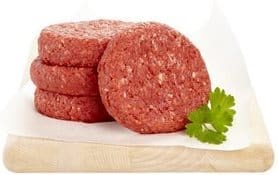AUSTRALIAN beef trade into the United States since Trump’s 3 April (local time) tariff announcements has gotten off to a surprisingly slow start.
On Friday, Urner Barry reported Australian/NZ blended cow 90s at a record high US334-338c/lb, FOB port of entry. However that price quote masks the fact that trade volume last week and this morning into the US has been thin.
 Some offer prices (not sale prices) quoted in industry circles this morning had imported 90s at US350c/lb, and domestic 90s at 380c. Clearly, current record high prices being quoted on lean imported trimmings into the US are now factoring in the new 10pc US tariff.
Some offer prices (not sale prices) quoted in industry circles this morning had imported 90s at US350c/lb, and domestic 90s at 380c. Clearly, current record high prices being quoted on lean imported trimmings into the US are now factoring in the new 10pc US tariff.
The premium for US domestic manufacturing beef over imported has also declined dramatically over the past 10 days since US president Donald Trump’s tariff announcements on 3 April.
US domestic fresh trimmings were trading as much as US80c/lb above equivalent imported product only a few weeks ago, but that gap has now narrowed to a more conventional level of just 30c/lb, as the full effects of tariff developments take effect.
“US participants in the imported beef sector continued to seek pricing references in an unsettled market,” Urner Barry’s Comtell report said on Friday. “Of the trade that was occurring, sellers have different approaches to the market, with some immediately reflecting the full value of new tariff rates in their nearby offerings, while others walk prices up and offer higher levels in forward time slots,” UB said.
“All of this had mixed levels of success with buyers. This contributes to wide price spreads and irregular pricing relationships between some listed items.”
Part of the slow response in buying out of the US trade since 3 April may be explained by the fact that Australian product currently on the water to the US, shipped up to 4 April (bill of lading) and due to arrive in US ports by 27 May, is exempt from Trump’s new 10pc tariff. It means that for a few weeks, that may mask any sudden rise in demand out of the US as the tariff impact starts to take hold, traders told Beef Central this morning.
The trimmings and general beef marketing into the US continues to be described by the trade as ‘unsettled’, ‘confused’ and ‘erratic’ this morning.
“It’s still a bit of a Mexican standoff – there hasn’t been a lot of product traded over the past week,” one large export trader with heavy exposure to the US said this morning.
“Despite the fact that many US importers are in need of beef, there’s a feeling that whoever goes first sets a price precedent,” he said.
“Some of the bigger US importers have already increased their offer prices by the 10pc (representing the tariff amount), but some of that may be product they already have in the country, to compensate for the product they now have on the water on which they have to pay an extra 10pc.”
 “But we are not hearing about a lot of new imported product being sold yet, under the new tariff regime. That may change in the next week or two.”
“But we are not hearing about a lot of new imported product being sold yet, under the new tariff regime. That may change in the next week or two.”
“That’s somewhat surprising, but we’ve seen at different times in the past during uncertain times that nobody (customers) wants to make a decision until they have more information. But we don’t know how much longer they (US trimmings customers) can hold-off for.”
Another large exporter agreed that US trade had been quieter last week, saying US customers were still processing all of the implications, including consumer uncertainty, stock market swings, currency and other factors.
“There’s still confusion and concern evident, as customers try to interpret what’s going on. This may take a few weeks to resolve,” the trade contact said. “Policies continued to change last week, with some Chinese-produced items (eg iPhones) already being excluded from the tariffs. Nobody is sure of where this is all heading.”
“The US market could be quiet for another month yet, just because of everything that’s been going on. But there’s no escaping the fundamental fact that the US faces a shortage of not only trimmings, but beef products in general,” another trade source said.
“National US kills last week (fed and non-fed cattle) were much lower than expected, at only 564,000 head.”
Currency movement is also exerting an influence in trade confidence in Aussie beef this month, with some of the wildest swings seen since COVID over the past ten days. The Aussie was worth US63.3c on 4 April, before crashing by 3.7c or 6pc to US59.6c by 9 April, then making a comeback to +63c on Friday. All that makes the trade even more hesitant, on top of the tariff impact uncertainty.
Lower Aussie production
Adding to current market supply-demand complexity, Australian production will be significantly curtailed over the next month. There are up to four short working weeks ahead for some processors, starting this Friday and the following Monday (Easter), followed by Anzac Day, and in Queensland, which accounts for close to half the nation’s beef production capacity, Labour Day. It means Australian production will be limited until the week starting 12 May, adding further supply pressure to the market.
China interest grows
While the US has been slow to respond in the new tariff era, other customers like China have reacted sharply. A number of large export processors reported a sharp rise in inquiry out of China last week, and again this morning.
US export beef that once found its way to China is now prohibitively expensive due to the tariff war, carrying a 125pc tit-for-tat tariff. The US last year exported around 180,000t to China, representing 16pc of shipments to all countries.
That’s sparked much improved inquiry (one exporter this morning described it as ‘crazy’) for Australian product. The range of cuts the Chinese are showing interest in has also grown, including grainfed middle meats – “not just the usual items China is interested in,” one exporter said.
Some of that is clearly about displaced US beef, was the broad conclusion. However Australia did not have the grainfed capacity to fill the entire void left by the absence of US grainfed cuts in markets like China.
At the same time, Brazil has also flagged greater volume heading into China, at the expense of the US, where Brazilian beef is now exposed to a 36.5pc tariff. Prices have also risen for Brazilian beef heading into the US this week.
On top of that, inquiry for Aussie product out of Japan and Korea last week was described as ‘solid’ and ‘stable’, especially since some favourable currency movements.
Repricing underway, both in US and overseas
Friday’s weekly imported beef market report produced for MLA by US-based Steiner Consulting confirmed many of the supply-demand signals outlined above.
“Given current uncertainly in the stock markets and consumer confidence worldwide since tariffs arrived, imported meat trade into the US has stalled,” Steiner said.
“Traders are currently adjusting prices to reflect the impact of tariffs and an uncertain outlook for the US dollar. Pricing data for CIF values, which importers pay in Australia or New Zealand, remains limited – partly due to a disconnect between what overseas suppliers are asking and what US importers believe the market can support.”
For now, traders and importers have raised FOB prices to reflect most of the tariff cost, Steiner said.
“But if they cannot sell the meat at these higher levels, they will likely go back and bid lower CIF prices to bridge the gap. So far, there appears to be little urgency from overseas suppliers to work with US buyers or traders to put more orders on the books.”
But don’t underestimate the power of momentum, Steiner warned.
Brazil, Australia, New Zealand and other suppliers exported significant volumes to the US in March, which should keep the US market well supplied into the second quarter. Brazilian beef shipments in March hit a record 35,000t while Australia shipped 32,300t and is expected to send another 35,000t in April.
“It may be that overseas suppliers feel comfortable for now, given existing orders and product already shipped,” Steiner said.
“But if that book of sales starts to thin just as US demand begins to soften, the situation could become much more problematic than it currently appears.”
This brought the focus back to demand, and the concern over potential for a financial crisis.
“We are reminded of Warren Buffett’s line: ‘Only when the tide goes out do you discover who’s been swimming naked.’ A flood of cash washed over the US economy post COVID, inflating asset values across housing, equities, and more. Many borrowed heavily against these inflated values.
Now, higher tariffs, especially a tariff war with China, represent a disruption serious enough to expose vulnerabilities and precipitate a crisis.
“We already know the playbook from 2008–09. Banks tighten lending standards; asset values decline; companies face insolvency and collapse; governments feel pressure to intervene; falling demand and job losses feed a vicious cycle of contraction.”
“For suppliers of imported beef, this is not a time for complacency,” Steiner warned.
“Perhaps the dark clouds on the horizon will clear. But if they are early signs of a coming hurricane, now is the time to batten down the hatches.”

HAVE YOUR SAY